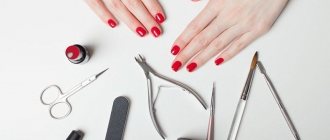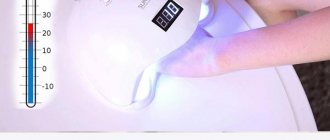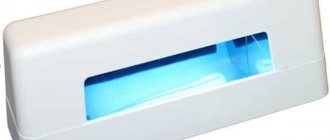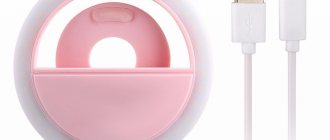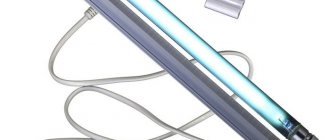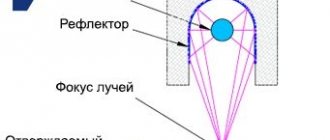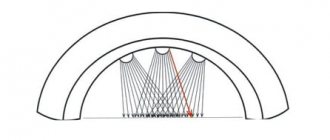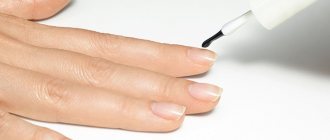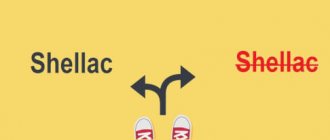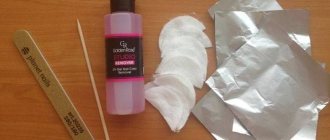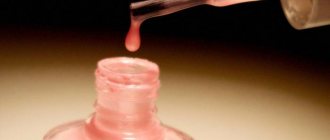Why do you need a manicure lamp?
For almost a decade now, women have been able to boast of long-lasting manicures, thanks to the invention of shellac. It is based on the same resin components, but now supplemented with a large list of excipients.
Any polish will eventually dry out on your nails. If a simple composition only needs a few minutes for this, then a complex composition will harden under natural conditions for a very long time. To accelerate the polymerization process, appropriate conditions are required.
The work is also complicated by the fact that gel polish is applied to the nail in several layers. Each one must be completely dry before the next one can be applied.
Note! Inexperienced fashionistas believe that drying can be accelerated with heat and blow the nails with a hairdryer. But this “know-how” will give the opposite result.
Directed streams of light of a certain frequency will facilitate the manicure procedure. Therefore, a lamp for shellac was invented, which no master can do without now.
The device is a durable plastic block. Model cases can be collapsible or cast. Lamps are available in various sizes and shapes. In some you can dry from 1 to 4 fingers according to a certain pattern, in others a full palm can be placed.
Polymerization process
Advantages and disadvantages of a 9-watt lamp for shellac
The 9-watt lamp for shellac impresses with its compactness and price.
Advantages:
- Small size and weight. Ideal for those who travel frequently and do not intend to give up a good manicure due to travel. Also suitable for manicurists who travel to clients’ homes.
- Low cost (from 800 rubles and above).
Flaws:
- It is impossible to dry all the fingers of one hand at once; the thumb will have to be dried separately.
- A narrow hole, which is why the lamp can get dirty with gel polish.
- In such a low-power lamp, gel polish will dry much longer than in a 36-watt lamp. It will take about 4 minutes to dry one layer of shellac. And it is possible that the shellac will not dry completely.
- Such lamps are rarely equipped with timers. It is not an “essential item”, but it is very convenient, as it allows you not to be constantly distracted by the clock.
We recommend: How to remove shellac from nails correctly and safely?
If you have a lot of time, are just starting to master shellac manicure and (or) are short on funds, then a 9-watt lamp is your choice.
Portable White Violeteer 9W from MelodySusie .
Its cost is $18.
- It features an elegant design and easy operation, ideal for home use.
- Wavelength: 365 nm.
- Input voltage range: 110-120 volts, 50/60 Hertz.
When choosing a 9-watt lamp for shellac, first of all, pay attention to the availability of warranty and post-warranty service. Such devices should be purchased only in specialized stores that have certificates certifying the quality of electrical equipment.
Types of lamps
Lamp for manicure
The industry produces a wide variety of gel polishes, differing in composition. Each of them has its own drying speed - some are adapted for short or medium wave parameters, others for long ones.
The first lamp for shellac is a UV device with a wide range. Today, there are other options for devices that ensure quick drying of the varnish coating.
Lamps for drying gel polish
| Type | Peculiarities |
| UV | Universal in use - ultraviolet light copes with all types of polymer varnishes. The low cost is attractive. Disadvantages: • dries nails longer than other types; • the device gets very hot; • light bulbs are fragile and quickly fail; • substances harmful to the body are released; • has a negative effect on the dermis and vision. |
| LED | Modern LED lamp. Has a higher polymerization rate than ultraviolet lamps. ICE is environmentally friendly and durable, lightweight and more compact compared to UV. Disadvantages: • suitable only for gel polishes marked “LED” on the bottle; • when the service life is exhausted, you will have to buy a new device (LEDs do not change); • costs more than UV. |
| CCFL | The peculiarity of the device is a cold cathode and a gas that emits light. During operation, no mercury vapor is released and the lamp does not heat up. Light does not have a negative impact on vision. The device is reusable throughout the day and is universal regarding the composition of varnishes. Disadvantages: • polymerization takes longer than in previous options; • the high price is not affordable for everyone. |
| SUN | The latest devices are characterized by the features of UV and LED lamps. Dries any varnish quickly. The device is equipped with a convenient display. The models are larger in size compared to simple UV ones. The price is acceptable not only for professional craftsmen, but also for home craftsmen. Disadvantage - due to the presence of ultraviolet elements, a small percentage of negativity is present. |
| LED+ CCFL | A hybrid of 2 types, borrowing the best qualities from the prototypes. Radiation is harmless and environmentally friendly. Universal application, fast polymerization speed. The only drawback of the model is that the device is expensive and belongs to the category of professional equipment. |
Professional model
Lamps for drying varnishes are also divided according to the control method. The majority of devices operate on the principle of manual on/off. New models – touch ones – are especially popular. This saves time and does not distract the master from the process, but they fail faster than mechanical ones.
Types and features
There are 3 types of such devices on the market:
- ultraviolet lamps, which were the first to appear on the market, and for this reason are overwhelmingly popular;
- LED, which are characterized by greater power and longer service life;
- gas light with cold cathode.
OPI LED
Ultraviolet
Each lamp is different in design and color, but you first need to pay attention to its technical characteristics. The first and most important characteristic is the power of work.
Ultraviolet lamps are available with power starting from 9W. It is better to choose a technique that will have a power of 35W or more, since it ensures the fastest drying of nails and allows you to treat all 10 fingers at once.
Professionals use products with a power of 45W. Their main advantage is their large size, which allows you not only to dry your fingernails, but also to use the device for a pedicure.
Among the disadvantages of ultraviolet products, one can note their rather short service life. Buyers often complain about the short-term nature of their work, but are delighted with the price. Ultraviolet models are now considered the most budget-friendly on the market.
Irisk 54W
LED and gas light
Now LED models are gaining popularity, that is, LEDs, which have much more power and practicality than ultraviolet variations. What advantages of such a product are usually noticed by users:
- The lamp provides much faster drying than the ultraviolet model (on average, it takes 5-10 seconds to properly fix the shellac).
- A wide variety of sizes: for home use you can purchase a model with a power of 6W, and for professionals, more powerful and larger options are suitable.
- Since LED lamps are considered more modern, they have a variety of nice little things, for example, touch activation.
- When used, shellac or gel polish does not heat up, so there is no unpleasant sensation.
The main disadvantage of LED lamps is the high price. It costs more than ultraviolet, but it usually works better.
LED 48W
And finally, there are cold cathode lamps, which are designated CCFL. Their main advantage is high power. This model can dry any varnish, including gel or shellac. Another advantage is its speed of operation, because on average it takes three seconds to process one finger.
On the market you can find combined LED and CCFL models that do not dry out the skin, and at the same time contradict all varnishes, providing the girl with a high-quality and beautiful manicure in a short time.
Polaris PNL-4018UV
How to choose a lamp for shellac
Lamp for eyelash extension
There are many beautiful models of manicure lamps on sale. But you shouldn’t immediately opt for the original design. To begin with, weigh the main factors that are important in the work of the master:
- if a girl does a manicure only for herself, she just needs to take a 9-watt UV device;
Low power UV model
- in cases where nail extensions are also planned, a more powerful ultraviolet lamp is needed - 36 W;
- if an inexperienced craftswoman is wondering what kind of lamp she needs for shellac, then she should also choose UV, as it is cheaper;
- For those who have already mastered the polymer technique of nail extension and coloring, a shellac LED manicure lamp is suitable for home use; it costs more, but the costs are completely justified;
- For professionals with a large clientele, a SUN type device is more suitable; it is universal, has high power (therefore, provides a high hardening speed);
- lamp models differ in dimensions; if the craftswoman is forced to carry the device with her when visiting a client at home, then she should choose a portable option, for which LED options are famous; but they are not equipped with a timer.
It is also necessary to take into account such a factor as the side effects of radiation. In this regard, ultraviolet radiation is considered harmful. Along with shellac, the UV lamp also dries out the skin. In powerful models, light negatively affects the eyes.
Which is better: UV or LED
Having gone to the store to buy something for personal use, the girl begins to think about which lamp is better for shellac, led or UV. Both options are suitable for home use. To make your final choice, it is recommended that you familiarize yourself with the features of each option.
Comparative review of LED and UV
| Characteristics | UV | LED |
| Wave range, nm | 315-400 | 400-410 |
| Power, W | 9-48 | from 1 to 9 |
| Polymerization speed, min. | 2-3 | 1 |
Note! If we consider the characteristics of both types of lamps, then UV is preferable. The wide wave range allows the device to be used for drying all types of varnishes. Whereas LED is designed for a certain type of polymer.
ICE or UV
Ultraviolet lamps are more powerful than LED lamps, which, on the one hand, is good. But the former quickly lose emitted power, while with LED it remains unchanged throughout its service life. At the same time, UV is short-lived - the light bulb needs to be changed frequently (operation duration is no more than 3 thousand hours). LEDs are not replaceable, but are designed for 50 thousand hours.
As for the polymerization speed, modern devices only need 1 minute to dry the layer. But in UV the varnish hardens evenly and does not bake precisely due to delayed polymerization.
When deciding which lamp is best for shellac, some focus solely on cost. Ultraviolet is cheaper, but even in this category there can be high prices, which depend on power, dimensions, the presence of a timer and other options.
Based on practicality, most people prefer LEDs. The investment pays off handsomely when you consider the service life of the device. In this case, you can choose a small model without a timer that can easily fit into a handbag.
What is the lamp for?
A shellac lamp is used for the purpose of polymerization, that is, drying, but to obtain a good result, the correct application technology must initially be used. There are two types of lamps:
- Ultraviolet lamp. The drying speed with it does not exceed a couple of minutes, it is possible to replace the lamps, and the cost is acceptable for everyone.
- LED lamp. The polymerization speed is about 20 seconds, but in such lamps there is no possibility of replacing LEDs, and the cost is much higher than UV lamps.
From the very beginning, ultraviolet lamps were more popular because they had many advantages. Therefore, they should be considered in more detail.
Advice from experienced manicurists
How to restore nails after shellac
When visiting a salon, women do not think about what kind of lamp the master uses for gel polish and shellac. When you decide to purchase a device for home use, it won’t hurt to start by listening to the advice of professionals:
- Powerful lamps speed up the polymerization process, but are the most expensive in terms of finances and also consume a lot of electricity. Therefore, it is more advisable for your home to purchase a device with average performance.
- If the salon often uses stationary equipment with many functions that facilitate the process, then for private craftswomen it is better to take a simpler, more compact device with less weight. It is convenient to store and take with you on trips (to the country, to a client, on a business trip).
Portable option
- Ergonomics and design are of great importance in creating a beautiful manicure. The convenient shape and pleasant colors of the body can influence the mood of both the master and the client.
- Based on price, you should not purchase inexpensive models (from 600 rubles to 3000). As a rule, they are manufactured by little-known companies that do not provide a guarantee of quality. These are the most simplified devices with a limited set of options.
Domestic and Chinese lamps for drying gel polishes, which are rational to buy for the home, will cost approximately 3-5 thousand rubles. (ultraviolet), 5-7 thousand rubles. – LED and gas. Professional models will cost several times more. As for hybrids, the lowest price for them is 40 thousand rubles*
*As of September 2022
Why are cheap lamps for drying shellac bad?
Inexpensive UV lamps for curing shellac have low power sources, which means they cannot produce the optimal amount of UV light needed to completely cure the gel polish.
- The thumb needs to be dried separately in a 9 W lamp. This leads to prolonged drying of the nails and, accordingly, faster wear of the lamp.
- The best choice is a 36W UV lamp, which has optimal power output. These are used in many professional beauty salons.
- Inexpensive lamps typically don't have an adjustable timer, but you need one if you want to see the difference between beautiful, flawless nails and sticky, wet, dull nails.
- Also, some budget lamps for drying shellac have a mirror surface only on the bottom of the lamp. Choose a lamp that has a reflective surface covering the inside of the lamp as well as the top and sides. This lamp ensures uniform drying of shellac for all fingers. Just remember to remove the protective film glued to the mirror surfaces of the new lamp.
- Inexpensive lamps have bulbs only at the top and no bulbs on the sides. This leads to the fact that the side surfaces of the nails and the nail on the little finger will not be completely dried.
